Trace A. DeMeyer's Blog, page 2
October 8, 2025
How is there still no office for Indigenous rights complaints?
 It has been six years since the idea arose among the Calls to Action in the 2019 Inquiry into Missing and Murdered Indigenous Women and Girls. MMIWG Call for Justice 1.7 urged the federal, provincial, and territorial governments to establish a formal mechanism to resolve complaints on Indigenous and human rights, to be developed in partnership with Indigenous peoples.
It has been six years since the idea arose among the Calls to Action in the 2019 Inquiry into Missing and Murdered Indigenous Women and Girls. MMIWG Call for Justice 1.7 urged the federal, provincial, and territorial governments to establish a formal mechanism to resolve complaints on Indigenous and human rights, to be developed in partnership with Indigenous peoples. GOOD READ: https://icmagazine.org/how-is-there-still-no-office-for-indigenous-rights-complaints/
Questions? EMAIL: tracelara@pm.meOctober 5, 2025
Can you finally see it ?
THE PLEA OF THE RAINFOREST! – And discover how we can help Indigenous peoples!

By Barbara Crane Navarro - Rainforest Art Project on October 3, 2025
photo: Renato Soares
« Hey - Look at me
We see you
We tried to show you
You never bothered to learn our language
You were always looking down
We’ve been warning you since the beginning
The land is alive
This land can’t be owned
This land is us
All of us
You wanted the stones
The Gold
Your shiny things
Titles - Flags - Profits
You called that progress
We tried to teach you
But you’ve always been so greedy
Too primitive - Too savage
To understand
Now you still bring curses over the Yanomami
Illnesses
And once again we are dying because of it
And all indigenous land is being turned into
ashes and mud
Five centuries
You never looked up to discover
what we were holding in place
The sky itself
Your cities can see it
Your crops can see it
Your kids can see it
We can see it in your lungs
Take a deep breath
Open your eyes and look up
Can you finally see it ?
Help the Yanomami hold up the sky
(This video contains flashing images - viewer discretion is advised):
Watch video:
“The Yanomami shamans who fight the xawara epidemic see the disease’s image appear in the form of strips of scarlet fabric. The xawara epidemic is approaching and its smoke is glowing red! It is making the sky become ghost and is devouring all the human beings in its path! It must be driven away!” – Davi Kopenawa, Yanomami spokesman and shaman, Roraima, Brazil
VIDEO:
Questions? EMAIL: tracelara@pm.me
Tribute Stamps for Truth and Reconciliation
Canada Post is commemorating this week’s National Day for Truth and Reconciliation with stamps featuring the iconic Bentwood Box of artist Luke Marston. The move is a tribute to Survivors and a symbol of healing, reconciliation and hope.
SOURCE: https://canadianartjunkie.com/2025/10/02/tribute-stamps-for-truth-and-reconciliation/#respond


The issue includes three unique stamps depicting the front and sides of the Bentwood Box and reflecting the distinct cultures of First Nations, Inuit and Métis, and their children who attended residential schools.
Hands Raised HelplesslyOn the stamp depicting the front panel of the box, crosses represent the churches that ran residential schools (with the federal government), while raised hands symbolize the helplessness felt by parents when their children were taken away and sent to residential schools.
The box by Marston, a renowned Coast Salish artist, was commissioned by Canada’s Truth and Reconciliation Commission in 2009 as a tribute to Indian Residential School survivors. It travelled across Canada with the commission during years of reconciliation hearings (see the commission’s finding of ‘cultural genoicide’ at the end of this post).
On the box, Marston depicts his grandmother’s experience at one of the church and government schools, where children were taken by the thousands and stripped of language and culture (see more about the history of Bentwood Boxes at this Art Junkie post).
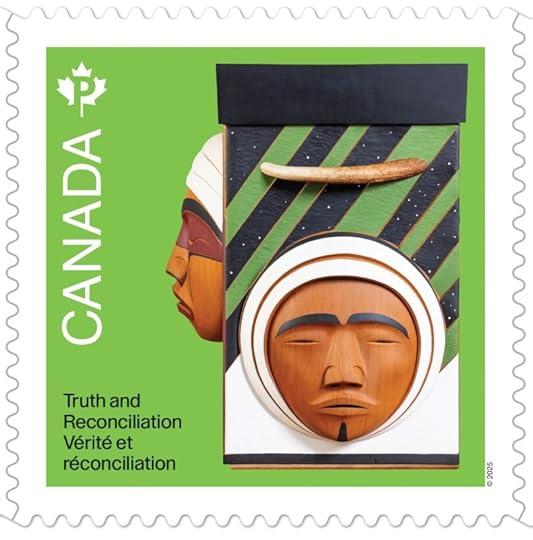
This stamp features a panel on the box that depicts the Inuit experiences at residential schools. The northern lights and stars in the background represent Inuit ancestors and teachings. Students were separated from this knowledge while at residential schools.
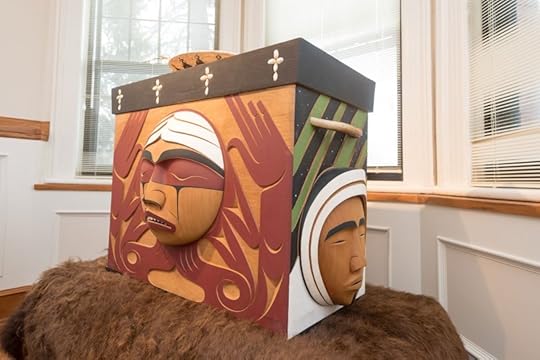 Front and side view of the box created by Luke Marston, from his website, here.
Front and side view of the box created by Luke Marston, from his website, here. On the third stamp below, a panel depicts student experiences from the Prairies and Eastern Canada. The infinity symbol, found on the Métis flag, acknowledges the Métis children who were taken.
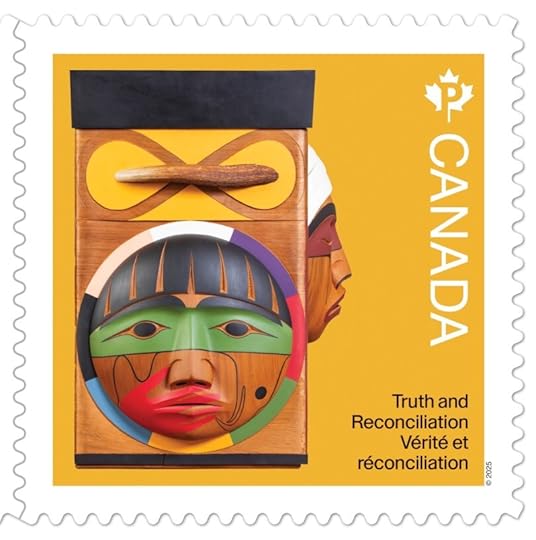 A Horrific Record
A Horrific RecordIf you are not familiar with the horrific record of Canada’s residential schools, the country’s National Centre for Truth and Reconciliation has an overview to help familiarize you with the issues here.
The easiest take-away from that site is:
The Truth and Reconciliation Commission of Canada (TRC) concluded that residential schools were “a systematic, government- sponsored attempt to destroy Aboriginal cultures and languages and to assimilate Aboriginal peoples so that they no longer existed as distinct peoples.” The TRC characterized this intent as “cultural genocide.”
Luke Marston’s website, here.
A Q&A about the Bentwood Box, here.
A Reuters photo site with archive images of children at residential schools, here.
Questions? EMAIL: tracelara@pm.meCAN'T LOOK AWAY (2025) - Official Trailer | JOLT
Can't Look Away, now available on Jolt: https://on.jolt.film/cantlookaway
Film Description
Can't Look Away is a gripping documentary that exposes the dark side of social media and its devastating impact on young users. Directors Matthew O'Neill and Perri Peltz take viewers inside the high-stakes legal battle to hold tech companies accountable for the harm caused by their negligence and dangerous algorithms. Based on investigative reporting by Bloomberg News' Olivia Carville, the film follows the Social Media Victims Law Center fighting for justice for families whose children suffered tragic consequences linked to social media use. As families seek justice, Can't Look Away underscores the urgent need for industry reform and serves as both a wake-up call about the dangers of social media—and a call to action to protect future generations.

Vermont is one state among many passing legislation to stop kids from using cellphones during school hours (bell-to-bell). Questions? EMAIL: tracelara@pm.me
October 4, 2025
Through Indigenous Eyes

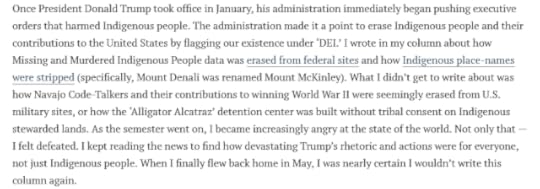
READ TUFTS STUDENT Sorsha Khitikian
Welcome back to another semester of “Through Indigenous Eyes.”
I realized that I never introduced myself last semester: My name is Sorsha Khitikian, and I am a junior at Tufts. I am Yurok, a tribe on the Klamath River in Northern California, but I grew up away from my tribe’s reservation, making me an ‘urban Indian.’
READ HERE: https://www.tuftsdaily.com/article/2025/09/through-indigenous-eyes-a-great-native-american-road-trip
Questions? EMAIL: tracelara@pm.meIndigenous Nations Sue Social Media Giants, Citing Youth Mental Health Harms...
NOW:
Historic lawsuits filed: The Chickasaw and Choctaw Nations have launched legal action against major social media companies, alleging their platforms fueled a youth mental health crisis.Harms to Indigenous youth spotlighted: The lawsuits argue that addictive design features and unchecked content disproportionately impact Native youth, exacerbating depression, anxiety, and suicide risks.Broader accountability push: The cases join a growing wave of litigation seeking to hold tech giants responsible for social harms, potentially setting major legal precedents.MORE: https://icmagazine.org/indigenous-nations-sue-social-media-giants-citing-youth-mental-health-harms/Questions? EMAIL: tracelara@pm.meFrom documentary to feature film
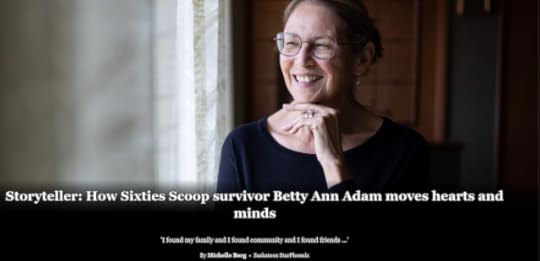
Betty Ann Adam says she grew up “not knowing who I was.”
Raised in a white foster home east of Prince Albert, she was told to call her caregivers “mom” and “dad” and accept their relatives as her own family.
Decades later, the award-winning journalist and filmmaker discovered the siblings and community she had lost to the Sixties Scoop.
“I was essentially trained to believe that I was better off because I was in a white context,” she said. “When I found my family and I found community and I found friends… It was my family. It was me.”
Now 66, Adam is a member of Fond du Lac Dene Nation, an intergenerational residential school survivor, and a child of the Sixties Scoop that saw about 20,000 Indigenous children taken from their families between the 1950s and 1980s.
Questions? EMAIL: tracelara@pm.meLouisiana prison guard unearthed over 100 skeletons and sacred objects at a grave site
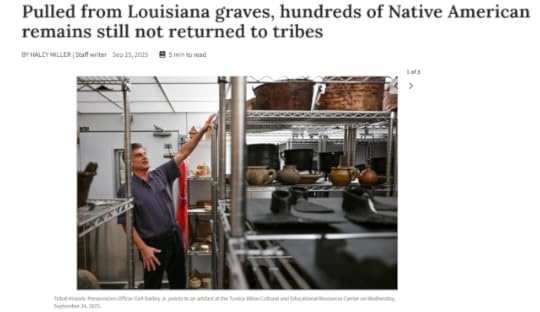
In 1968, a Louisiana prison guard unearthed over 100 skeletons and sacred objects at a grave site in West Feliciana Parish, exposing them to the light for the first time in centuries.
He kept the items, precious pieces of handmade Tunica pottery and traded European goods. Those could be sold.
He tossed the remains into the Mississippi River.
Questions? EMAIL: tracelara@pm.me60s Scoop: That little sister was Elizabeth
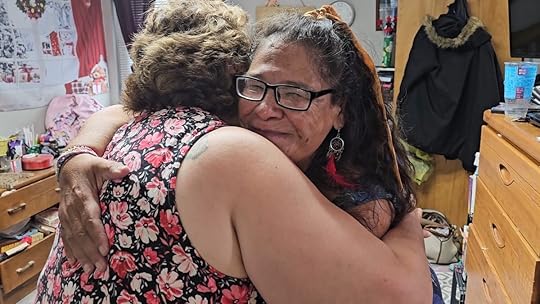 Cindy Munro, right, embraces her sister Elizabeth Kostecky during their emotional reunion in North Dakota. Kostecky was removed from the family in Canada during the Sixties Scoop and adopted by a White family in Minnesota. Credit: Coleen Rajotte for ICT
Cindy Munro, right, embraces her sister Elizabeth Kostecky during their emotional reunion in North Dakota. Kostecky was removed from the family in Canada during the Sixties Scoop and adopted by a White family in Minnesota. Credit: Coleen Rajotte for ICT Coleen Rajotte
Special to ICT
FARGO, North Dakota — Lorraine Sinclair had been waiting for this moment her entire life.
Sinclair and her siblings, Cindy and Gerald Munro, traveled from Northern Manitoba in Canada to North Dakota to finally meet up with their long-missing sister.
Now known as Elizabeth Kostecky, she was taken from their family in 1971 during an era known as the Sixties Scoop, a period when Canadian authorities removed an estimated 30,000 First Nations, Métis and Inuit children from their homes. The siblings, who are Cree from the Sapotewayak Cree Nation in Manitoba, were among them.
Many of the Native children caught up in the Sixties Scoop were adopted into non-Native families across Canada, the United States and beyond. Elizabeth was just 1 year old when she was adopted by a White family in Minnesota. Lorraine, Cindy and Gerald were also taken from their mother and placed into foster care, where they were largely raised in separate households.
The three reunited in the early 1990s, but they had not seen Elizabeth in decades, if ever.
The siblings’ journey in mid-August took them from Fargo to Ellendale, a two-hour drive, where they knew their sister was waiting. Elizabeth is currently a ward of the state of North Dakota and is in an assisted-living facility, they said.
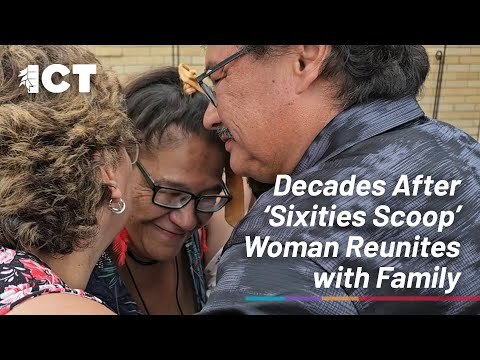
When they arrived, the emotional reunion began at the front door, where Elizabeth was waiting. Tears and hugs filled the air as the four siblings embraced. They are now trying to get her returned to Canada.
“Everybody has to find their family,” Lorraine said. “We can’t leave anybody behind.”
The family story
Cindy and Lorraine were taken away as toddlers from their home in Birch River, Manitoba. Cindy was 3 and Lorraine was just 2. They were placed in a foster home on a farm, but they were then moved around to other placements.
Both sisters say they were abused during their time in foster homes. Cindy recalls that “social workers never checked up to see if we were safe.”
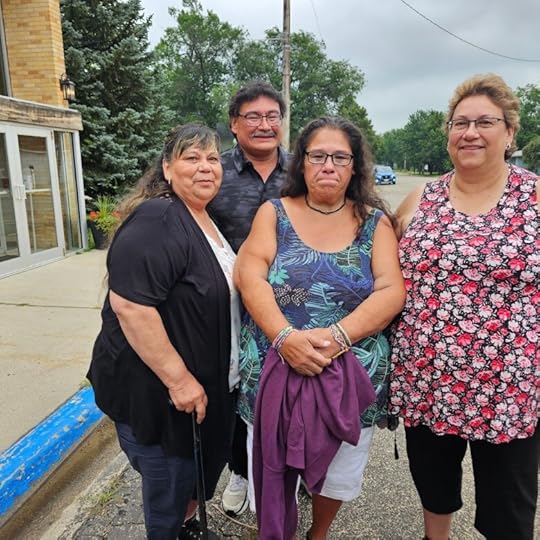 Reunited at last: Siblings, from left, Lorraine Sinclair, Gerald Munro, Cindy Munro and Elizabeth Kostecky gather in North Dakota after being reconciled decades after Kostecky was taken from the family during Canada’s Sixties Scoop. Credit: Coleen Rajotte for ICT
Reunited at last: Siblings, from left, Lorraine Sinclair, Gerald Munro, Cindy Munro and Elizabeth Kostecky gather in North Dakota after being reconciled decades after Kostecky was taken from the family during Canada’s Sixties Scoop. Credit: Coleen Rajotte for ICTThe two sisters found each other again when they attended the same high school in Swan River, Manitoba. By then, Cindy had run away and was living in a motel while attending high school. She cleaned rooms at night, and Canada’s social assistance program paid her accommodations.
They had no idea their mother had given birth to their younger brother, Gerald, and younger sister, Elizabeth. The younger siblings were in Winnipeg, and they did not find out about them until they were adults. In all, they were among 11 children in the family, four of whom have died.
Their dad died in 1974. To this day, none of the children has ever found their mother.
Elizabeth’s story
Elizabeth was adopted by an American family in Minnesota, and by all accounts, had loving adoptive parents. Her parents owned a fishing and hunting lodge where Elizabeth worked.
She described experiencing racism as a child in school. “They would be very mean to me,” she said. “They would powwow around me, make sounds, wear feathers — always trying to make fun of me.”
 A childhood photo of Elizabeth Kostecky, who was taken from her family in Canada in 1971 during the Sixties Scoop. She was adopted by a White family in Minnesota and finally reunited with her siblings in August 2025 in North Dakota. Credit: Courtesy photo
A childhood photo of Elizabeth Kostecky, who was taken from her family in Canada in 1971 during the Sixties Scoop. She was adopted by a White family in Minnesota and finally reunited with her siblings in August 2025 in North Dakota. Credit: Courtesy photoElizabeth said she hadn’t realized just how many Indigenous children were taken during the Sixties Scoop. “I only met one Native my whole life growing up,” she said.
About four years ago, her adoptive parents died, just months apart, she told ICT. The lodge was sold and Elizabeth said she did not get any money from the sale.
Shortly afterward, she ended up in an assisted living facility and became a ward of the state of North Dakota. Elizabeth told her siblings she was told she had memory problems.
Reuniting
Cindy and Lorraine were able to find Gerald in the 1990s. Gerald told them he had a little sister who was taken away while he was a toddler in Winnipeg. That little sister was Elizabeth. Cindy and Lorraine, who remain very close to this day, began the search.
They were able to track her to North Dakota after someone told them she’d been adopted by the family that owned the hunting lodge. This led to phone calls and the eventual trip to North Dakota in early August.
Elizabeth told ICT she didn’t expect to end up in North Dakota without family nearby. She said she was placed in an assisted-living facility following an arrest related to a drinking incident years ago.
Looking ahead
The siblings say they are determined to bring Elizabeth back to Canada. Upon their return to Canada, they were able to obtain Elizabeth’s Canadian birth certificate and are consulting a lawyer about removing the legal restraints that keep her in the U.S.
“I think our sister would be capable of looking after herself, maybe with a little help at first,” Lorraine said.
The siblings visited in the lobby of the facility where Elizabeth lives, in a clean, institutional dining room that overlooks a string of old brick buildings in Ellendale.
There were lots of tears as they sat close to one another. The siblings brought gifts for Elizabeth – craft supplies, a smudge bowl and traditional medicines. They ate lunch together at the local Subway.
They found a park where they could smudge together. But the one-day visit came to a close too soon, and the three dreaded leaving their sister alone.
The only contact they have had since they returned home is through Facebook. Elizabeth messages them to say she loves them.
The siblings say their story draws attention to the thousands of families separated during the Sixties Scoop, and that work is still needed to help survivors return home.
As they said their goodbyes, the siblings promised this was not the end of their time together.
“It’s not goodbye,” one said. “It’s ‘see you later.’”
SOURCE: https://ictnews.org/news/canadian-siblings-reunite-with-long-lost-sister-taken-in-the-sixties-scoop/
Questions? EMAIL: tracelara@pm.meSeptember 29, 2025
Remaining Native + Clear Sky (films)
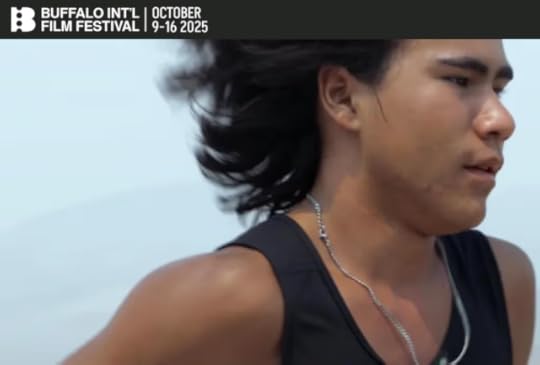
BIFF (Buffalo International Film Festival Premier)
Ku Stevens (17) is the solo runner at his high school with no coach. Living on the Yerington Paiute reservation in Northwest Nevada, he is driven by his ambition to run for his dream school, the University of Oregon.
As Ku trains, unreconciled emotions unearth the memory of his great-grandfather, Frank Quinn. At 8 years old, Frank ran 50 miles across the desert to escape an Indian boarding school. Frank’s story becomes interwoven with Ku’s journey to run a collegiate qualifying time.
This coming-of-age documentary is told from Ku's perspective as he struggles to navigate his dream of becoming a collegiate athlete as the memory of his great grandfather's escape from an Indian boarding school begins to connect past, present, and future.
Will Ku outrun his history or will he learn to run in parallel with it to achieve his dreams?
Presented in partnership with the Office for Diversity, Equity, and Belonging for the College of Arts and Sciences at University at Buffalo – The State University of New York.
TICKETS and MORE: https://www.buffalofilm.org/events/remaining-native/
Clear Sky October 16, 4 PM North Park TheatreDirector Michael Del Monte in attendance.
Given up for adoption the day he was born, Shawn’s life spirals into addiction as he struggles with a broken connection to his Anishinaabe culture and a deep resentment toward the mother who abandoned him. Through intense psychedelic therapy and the relentless grind of distance running, CLEAR SKY follows Shawn’s fight to save his life, culminating in a cross-country road trip to confront the person he resents most: his mother. Filmed over three years, this intimate story bridges ancient traditions and modern science. Hailed by Derek Cianfrance (Blue Valentine) as 'a cinematic masterpiece,' CLEAR SKY is an unflinching portrait of one man’s journey to heal and find his place in the world.
Yurly | Country October 16, 11:30 AM North Park Theatre
A vivid ode to land and an intimate, inspiring portrait of an Indigenous Elder’s final year as he fights to reclaim his homeland, scarred by the largest contaminated site in the Southern Hemisphere. Banjima Elder Maitland Parker calls his yurlu (homeland) in the Pilbara region of Western Australia “poison country”; this haunting truth is etched into his body as he lives with terminal mesothelioma, an aggressive cancer resulting from asbestos exposure. Six decades prior, the Wittenoom mines left behind more than three million tonnes of waste rock laced with deadly asbestos fibres, turning 46,840 hectares of Banjima Country – an area eight times the size of Manhattan – into a toxic exclusion zone. Today, Aboriginal communities in Western Australia have the world’s highest mortality rate from mesothelioma. Yurlu | Country follows Maitland as he confronts government inaction and corporate greed in the hope of allowing his people to reconnect with and heal their ancestral lands. This powerful documentary bears witness to Australia’s very own – albeit largely unknown – Chernobyl-style disaster. Braiding imagery of beautiful yet contaminated terrain with poignant interviews and damning archival footage, the film stands as a testament to First Nations resilience amid ongoing dispossession, and is a rousing call to action to redress the cultural, environmental and physical wounds caused by colonisation and industry.
Shorts:
Climate Stories + Earth Works: “Kanenon:we - Original Seeds”
Next Gen: Peace Flags + 35,567 Yup'ik Stories
Racial Justice in View: My Name Is Not Amy
Resilience + Resistance: the Bone Comb
Trace A. DeMeyer's Blog
- Trace A. DeMeyer's profile
- 2 followers



